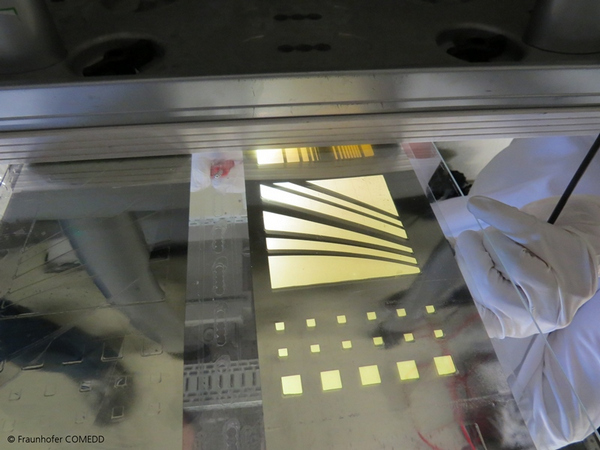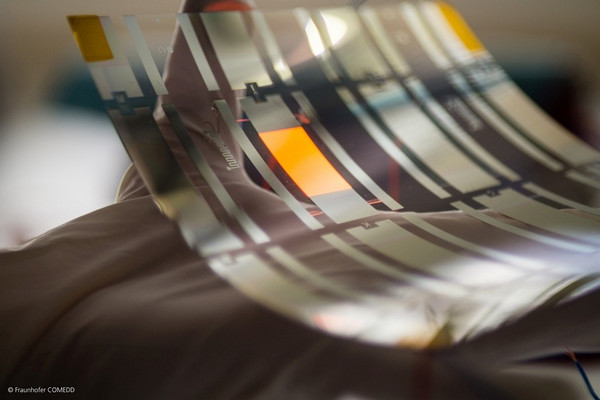OLED on flexible substrates offer unique scopes for luminaire designs. Additionally, they can be quasi transparent when switched off. Next to their appearance another aspect is of importance: the substrate they are processed on - like e.g. very thin flexible glass-, metal- and plastic foils.
In the last years the Fraunhofer Research Institution for Organics, Materials and Electronic Devices COMEDD – well established as the center of the European OLED research – has developed OLED devices on sheet batch type processing and on roll-to-roll process on flexible glass. The OLED device integration on flexible glass offers the opportunity to make a big step in approaching required device lifetimes.
Dr. Stefan Mogck, head of department Roll-to-Roll Organic Technology at Fraunhofer COMEDD, proudly states: “We have achieved great results in the processing of OLED on thin glass and at the same time we gathered a lot of new know-how about the handling of these kind of substrates. “
 |
|
Large area bottom emitting OLED light on flexible glass (area of 10 x 10 cm²) processed with Roll-to-Roll technology (LEDinside/Fraunhofer COMEDD). |
Furthermore, the close collaboration with Fraunhofer FEP strengthens the organic device integration on flexible substrates. Especially, the roll-to-roll manufacturing on flexible glass needs a lot of experience in web handling and equipment modification. The activities have been achieved on the Fraunhofer COMEDD Roll-to-Roll R&D line. Together with our partners VON ARDENNE GmbH for the development of process equipment and Nippon Electric Glass Co., Ltd., who provided flexible glass rolls “G-Leaf”, we are working on the improvement of process integration and the development of devices.
Furthermore, Fraunhofer COMEDD scientists work on proper and reliable electrical contacts for flexible OLED area lighting. A key technology is the printing of highly conductive metal lines which need to be integrated in the thin film small molecule OLED stack devices.
These results provide new opportunities of flexible glass in the field of building integration for smart signage and lighting integrations. In particular, on curved surfaces with the potential for high OLED lifetime comparable with devices obtained on rigid glass - In contrast to polymer based barrier film encapsulation with currently lower expected lifetime.
 |
|
OLED on thin glass processed with sheet-to-sheet technology. (LEDinside/Fraunhofer COMEDD). |
At LOPE-C 2014, Fraunhofer COMEDD will present latest results in OLED lighting on flexible glass. Besides the exhibition Dr. Stefan Mogck will give a talk: “OLED on flexible glass from Sheet-to-Sheet to Roll-to-Roll fabrication” on Monday, May 26th at 04:20 pm, at the scientific conference.
Furthermore we would like to inform you about the presentation of Dr. John Fahlteich of Fraunhofer FEP on May 28, 11:30 am at the Technical Conference with the topic: “Ultra-high permeation barriers and functional films for large-area flexible electronics”.
Besides the presentation Claus Luber of Fraunhofer COMEDD also presents a poster with the topic “Development and characterization of Ultra high barrier for organic electronics using atomic layer deposition and Ca mirror test” at the Technical Conference Poster Session 2014 on May 27.













